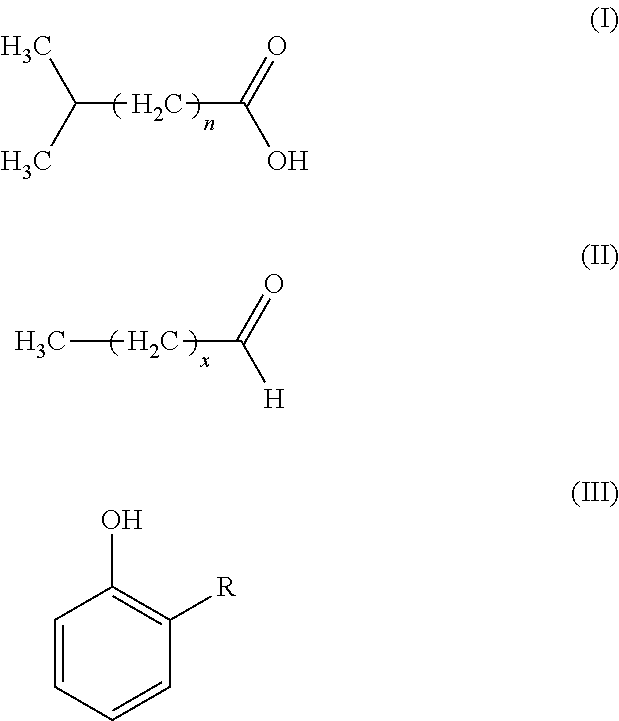Compositions for attracting blood-feeding insects
a technology for insects and compositions, applied in the field of compositions suitable for controlling the behaviour of insects, can solve the problems of increasing the cost of treatment, affecting the economic benefits of malaria treatment, and reducing the burden on the economy
- Summary
- Abstract
- Description
- Claims
- Application Information
AI Technical Summary
Benefits of technology
Problems solved by technology
Method used
Image
Examples
example 1
Comparison of Mosquito Catches by Traps Baited with a Synthetic Blend and with a Light Trap
[0059]Preparation of Attractant Formula.
[0060]An attractive human foot odour was obtained, and a synthetic blend was prepared using eight constituents that were found in the natural odour. The proportions of the eight constituents in the synthetic blend were equal to the relative proportions found in the natural foot odor. The constituents and amounts (% weight) were: isobutyric acid (1%); isovaleric acid (2%); octanal (1.5%); nonanal (24%); decanal (62%); dodecanal (4%); tridecanal (3.8%); and 2-methylphenol (1.6%).
[0061]Testing Procedure for Attractant Formula.
[0062]The average catches of a counter flow geometry (CFG) trap (American Biophysics Corporation) baited with a synthetic blend of eight constituents that make up the attractive mixture of human foot odours (i.e. isobutyric acid, isovaleric acid, octanal, nonanal, decanal, dodecanal, tridecanal, and 2-methylphenol) were compared with t...
example 2
Comparison of Mosquito Catches in Traps Baited with a Synthetic Blend and a Human Volunteer
[0065]The average catches of a counter flow geometry (CFG) trap (American Biophysics Corporation) baited with the synthetic blend prepared in Example 1 was compared with those of a bed-net trap [Mathenge et al. (2002), Medical and Veterinary Entomology, 16, 1-8] a human-baited exposure-free trap, also referred to as ‘Mbita trap’. Each comparison was performed repeatedly between 20:00 hrs in the night and 06:00 hrs the following morning under semi-field conditions in a screenhouse (11.5×7.1×3.0 m) also at Mbita Point on the shores of Lake Victoria. The two types of traps in each test were located at the corners of the screenhouse and were interchanged before each replicate. 200 starved laboratory-reared female An. gambiae s.s. were released from a cup placed at the center between the two traps being compared and the number of mosquitoes caught in each trap counted. The relative catch sizes of e...
example 3
Comparison of the Performance of a Blend of 8 Compounds with Complete Foot Odour
[0068]Number of wild mosquitoes trapped in pairs of CFG traps baited with fresh cotton socks either (i) treated with 1 g of 10% blend of 8 compounds (i.e. isobutyric acid (1%); isovaleric acid (2%); octanal (1.5%); nonanal (24%); decanal (62%); dodecanal (4%); tridecanal (3.8%); and 2-methylphenol (1.6%)) in Vaseline, or (ii) worn for 12 hours by a selected individual, were compared in a human dwelling in Lwanda, Suba District, in Kenya. In an earlier series of tests with foot odours collected from 16 persons, the selected individual was consistently found to be one of two with the most attractive natural foot odour (8-fold more attractive than the least attractive foot odour). The tests were conducted in a 12×8 ft room with a bed occupied by the owner of the household who volunteered to participate in the experiment. Every evening two traps, one freshly baited with socks treated with the test blend in V...
PUM
 Login to View More
Login to View More Abstract
Description
Claims
Application Information
 Login to View More
Login to View More - R&D
- Intellectual Property
- Life Sciences
- Materials
- Tech Scout
- Unparalleled Data Quality
- Higher Quality Content
- 60% Fewer Hallucinations
Browse by: Latest US Patents, China's latest patents, Technical Efficacy Thesaurus, Application Domain, Technology Topic, Popular Technical Reports.
© 2025 PatSnap. All rights reserved.Legal|Privacy policy|Modern Slavery Act Transparency Statement|Sitemap|About US| Contact US: help@patsnap.com



